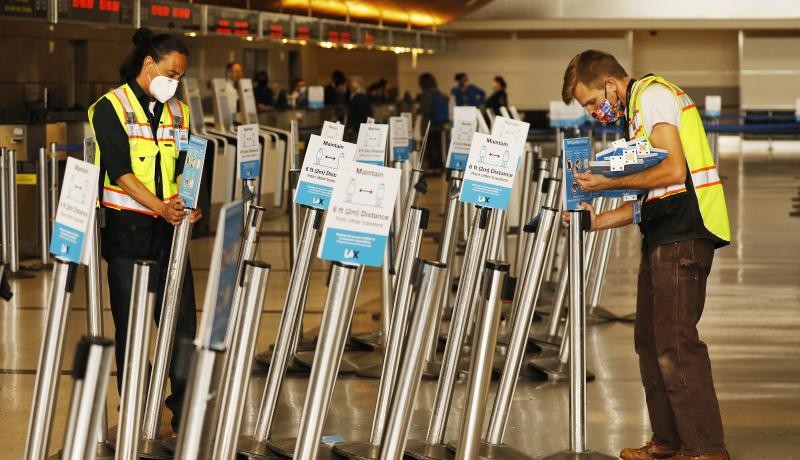
The great majority of countries have imposed partial or total travel bans on incoming non-residents since COVID-19 was declared a public health emergency by the World Health Organization (WHO) on January 30.
Yet at the time of declaring the emergency WHO said there was ‘no reason for measures that unnecessarily interfere with international travel and trade’.
On January 31, President Donald Trump announced a ban on people entering the United States from China. By the end of March about 150 countries had implemented travel restrictions.
Why does WHO offer such guidance?
WHO’s guidance on travel and trade derives from the International Health Regulations (IHR), agreed by WHO member states in 2005. Their purpose is 'to prevent, protect against, control and provide a public health response to the international spread of disease in ways that are commensurate with and restricted to public health risks, and which avoid unnecessary interference with international traffic and trade.’
There are three strands in WHO’s position. First, WHO is concerned that countries may be reluctant to notify it of an emerging infection (as the IHR obliges) if they believe it will result in economically damaging restrictions imposed by other countries (for instance, affecting trade or tourism). Second, travel bans cause problems for the supply of technical assistance and essential supplies to affected countries.
Third, WHO believes that travel restrictions are ineffective in most situations and that domestic measures to contain outbreaks (such as testing, isolating the sick, and contact tracing or social distancing) are far more important. However, it accepts that temporary restrictions may be justified at the beginning of an outbreak in order to buy time – ‘even if only a few days’ – for increasing preparedness. Such restrictions should be proportionate to the public health risk, short in duration and regularly reviewed.
So why have countries ignored WHO?
Initial flight cancellations resulted directly from China’s lockdown in Wuhan on January 23 which closed the airport. In late January many governments advised their citizens against travel to China, which led many airlines to cancel all flights to China. In March, as it became clear that the epidemic was spreading very fast, particularly in Europe and the US, most countries introduced travel bans.
The evidence of past studies on influenza and a few other emerging diseases suggests travel bans have limited effect. A review of their impact in the 2009 H1N1 epidemic concluded that even very drastic restrictions taken early on might have delayed its spread by three to four weeks, with limited impact on the ultimate size of the pandemic.
The impact was weakest where the virus had, like COVID-19, relatively high transmissibility. One early study on the spread of COVID-19 suggested that travel restrictions have little effect unless supported by domestic measures to reduce transmission. However, the study notes the lockdown in Wuhan, by slowing the international spread from Wuhan directly and indirectly from elsewhere in China, temporarily reduced imported cases in other countries by 80 per cent up to mid-February.
The evidence from previous outbreaks largely supports the position taken by WHO – but it mainly relates to outbreaks of flu or other emerging diseases whose characteristics are significantly different from COVID-19. Moreover, the global impact of COVID-19 is of a different order of magnitude to any outbreaks since the Spanish flu in 1918. In particular, the disease has achieved a global spread far more rapidly than most governments seem to have anticipated.
By the time WHO announced a public health emergency and Trump announced his travel ban there were already recorded cases in 18 countries other than China, including in Europe and the US. In those circumstances, a ban on travel from just one country is unlikely to be effective.
A recent study estimates that about 60,000 passengers travelled from Wuhan to 382 cities outside China during the two weeks prior to its lockdown, of whom about 1.4 per cent were likely to have been infected. In January alone, 328,000 Chinese citizens arrived in the US.
By the time most other countries announced their travel bans in March, the epidemic had affected most of Europe and the US and been declared a pandemic by WHO. This is why so many countries introduced global bans on incoming non-residents while also advising their residents not to travel.
It seems most countries were closing the stable door after the horse had bolted. It is understandable that governments, frightened by the exponential growth of cases from early March in many countries, adopted a belt and braces approach including lockdowns and travel bans. However, the evidence that travel bans at that stage of the epidemic made a material difference to the developing pandemic is largely absent while also having the side effect of stranding numerous travellers abroad.
Where travel restrictions may have an effect is when the case level is very low at the beginning of an outbreak, or as case numbers decline to low levels as it is controlled. Then imported cases could be an important focus for outbreaks. Thus, while the threat from rising cases in Western countries grew, travel or quarantine restrictions were introduced in countries such as South Korea and China which had managed to restrict their outbreaks.
In New Zealand, borders were completely closed before it had experienced any deaths, and Australia pursued a similar strategy. Both have been very successful so far in suppressing the disease rather than just delaying it for a few days in the way WHO envisaged.
WHO’s emergency committee of advisors asked WHO this month to update its recommendations on travel measures. The experience of the COVID-19 pandemic, including the speed of its truly global spread, requires WHO to rethink its approach to travel restrictions.
Dr Charles Clift, Senior Consulting Fellow, Global Health Programme and Lieutenant-General (Retd) Louis Lillywhite, Senior Consulting Fellow, Global Health Programme.
